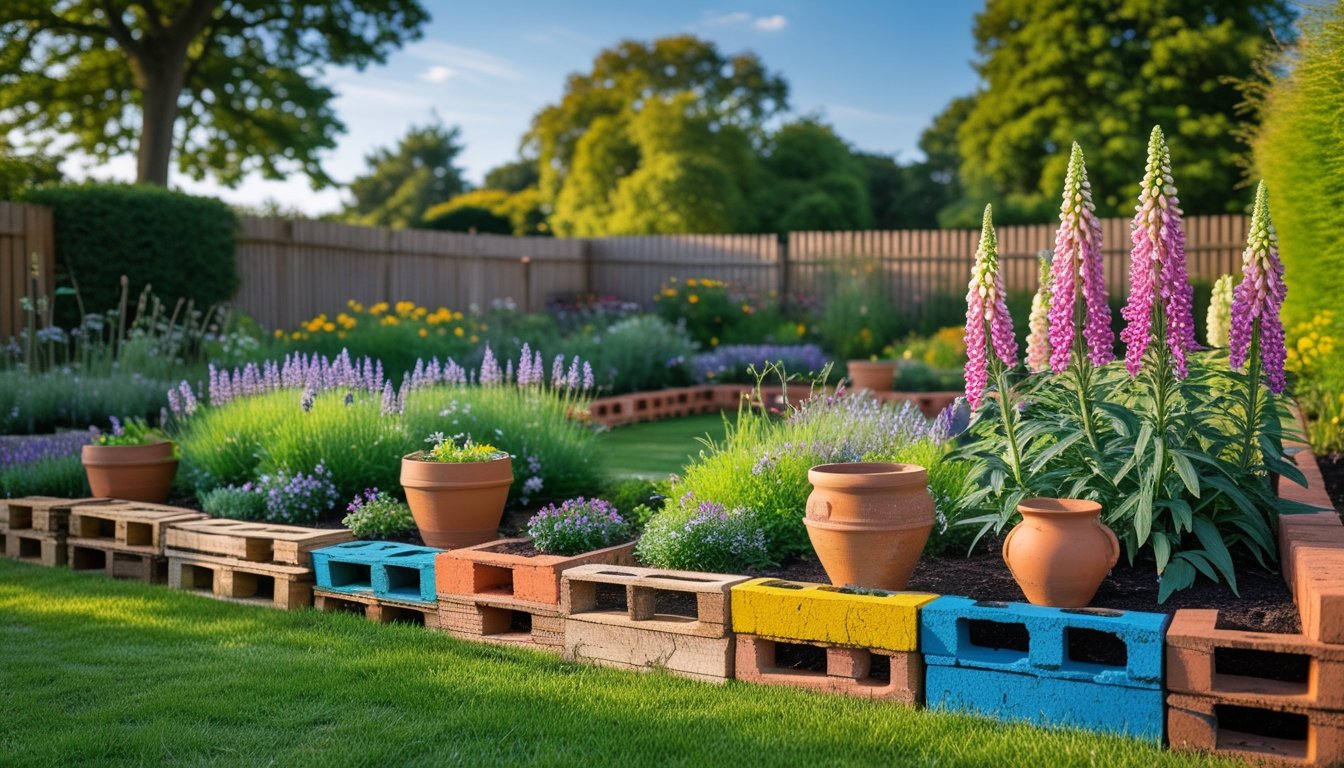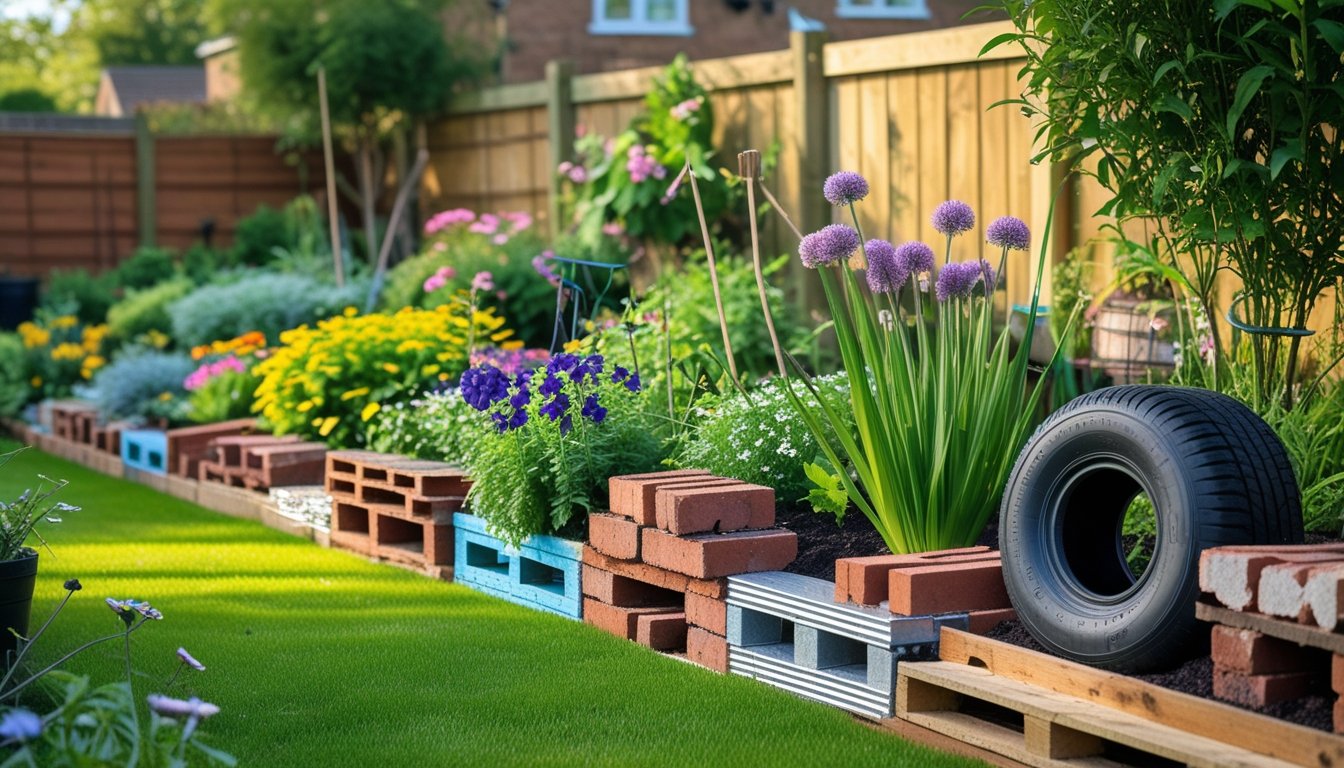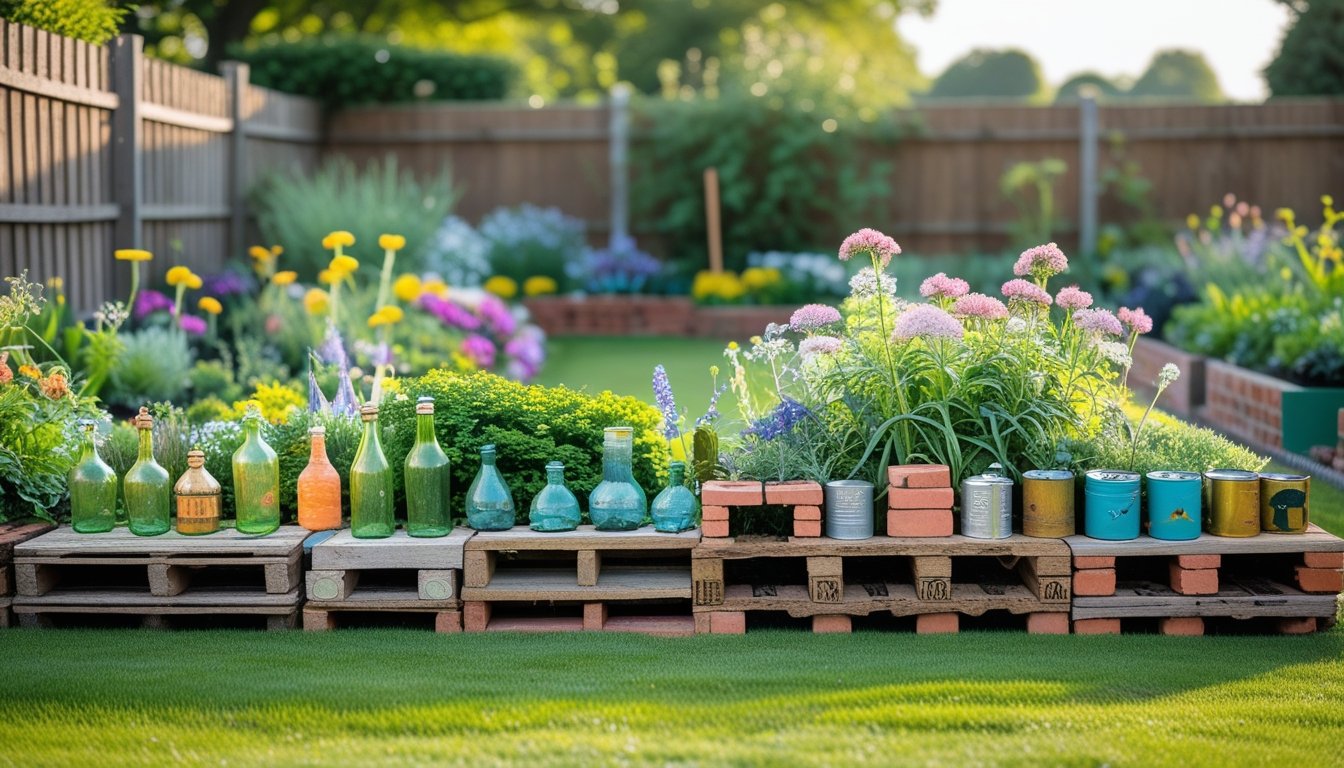Late updated: 20 Aug 2025 09:08
Written by: Emily Thornton
Creative UK Garden Borders With Recycled Materials: Sustainable Design Tips
Gardening is becoming more than just cultivating plants; it's a way to showcase creativity while caring for the environment. By incorporating recycled materials into our garden borders, we not only add a personal and eco-friendly flair but also reduce waste significantly. Using recycled materials for garden borders offers a cost-effective method that breathes new life into old objects, turning them into unique and beautiful garden features.

Old bricks, reclaimed wood, and even wine bottles can serve as the perfect base for innovative garden edging. These materials allow us to shape and define our garden spaces in ways that resonate with the natural beauty of the UK landscape. By transforming discarded items, gardens can reflect personality and style, making them both distinctive and sustainable.
As we explore different garden border ideas, we're delving into a world of creativity that emphasises sustainability and resourcefulness. Whether it's repurposing materials found in our basements or sourcing from local salvage yards, the options are endless. This journey of turning the ordinary into extraordinary can inspire gardeners of all levels to embrace eco-conscious gardening.
Key Takeaways
- Recycled materials offer cost-effective garden borders.
- Unique garden features can be created from old objects.
- Eco-conscious designs reduce waste and enhance beauty.
Creative UK Garden Borders With Recycled Materials

In this section, we explore the multiple benefits of using upcycled materials for garden borders, identify some of the best recycled materials available, and share essential tips for sustainable installation. Our focus is on practicality, aesthetic appeal, and environmental responsibility.
Benefits of Upcycled Garden Edging
Using upcycled materials for garden edges offers a unique, eco-friendly approach that helps save money and reduces waste. By reusing items like old bricks, bottles, and tiles, we can create distinctive designs that add character to our gardens.
Another benefit is the versatility in design. Upcycled materials allow us to unleash creativity, as they come in various shapes, sizes, and colours. This flexibility enables us to craft custom borders that reflect personal tastes and suit the garden's overall theme.
Finally, choosing recycled materials promotes environmental sustainability. Instead of discarding usable resources, we repurpose them to enrich our garden spaces. This practice aligns with sustainable gardening principles and contributes positively to the environment.
Top Recycled Materials for Garden Borders
Among the most popular recycled materials for garden borders are reclaimed wood, which adds a rustic charm, and old bricks for a classic look. Both materials are readily available and can be arranged in various patterns to create striking garden edges.
We can also use materials like wine bottles, tyres, or ceramics. Wine bottles, when buried neck down, create a colourful glass border, while tyres painted in vibrant hues make playful garden dividers. Ceramics, including broken tiles, can be mosaicked together for a unique artistic edge.
Another option is metal, such as corrugated iron or old fencing. These materials offer durability and industrial appeal, providing both function and beauty to a garden setting.
Essential Tips for Sustainable Installation
First, we need to plan our layout carefully, considering the garden's dimensions and our aesthetic goals. Recycled materials can vary widely in size, so it's important to have a clear vision before beginning installation.
Secondly, when securing the materials, such as digging trenches for heavy items like bricks or tyres, we should ensure stability without damaging existing plant life. Keeping everything level is crucial for both appearance and longevity.
Lastly, regular maintenance will ensure the garden borders remain attractive. Checking for any wear or damage allows us to address issues promptly and maintain the garden's appearance and functionality.
Inspirational Ideas for Unique Recycled Garden Borders

Exploring the artistic potential of recycled materials can transform ordinary garden spaces into extraordinary showcases. By using a mix of bottles, vintage objects, natural elements, and creative metal, we can create a unique garden border that speaks to both aesthetic and sustainability.
Bottle and Glass Borders
Recycling bottles and glass can add a vibrant touch to garden borders. Using glass bottles, often available in various colours, we can arrange them upside down along a path. This creates a striking and colourful line that catches the sunlight beautifully.
For those with a creative flair, crafting mosaics from broken glass pieces is another option. Creating intricate patterns using different colours and shapes introduces a personal artistic touch. Consider safety when handling and shaping glass, as sharp edges can pose risks.
Vintage and Antique Upcycled Borders
Embrace nostalgia with vintage and antique finds. Repurposing items like old crockery offers charming and whimsical border design. Plates and saucers can be inserted into the soil, forming a continuous low boundary that enchants the eye.
Another intriguing idea involves using antique tools—think old spades or garden forks—as unique stakes or decorations. These elements introduce a narrative, telling a story of past use and craftsmanship. When incorporating such items, the key lies in balancing practicality with artistic expression.
Natural Wood and Wattle Fencing
For a rustic and earthy feel, natural wood and wattle fencing provide excellent options. Using branches and twigs, we can weave traditional wattle fences that bring character and a handcrafted look to garden borders. This technique not only showcases sustainable practices but also respects centuries-old craft traditions.
Natural log borders can also be created from cut tree trunks or branches. By varying sizes and arranging them vertically or horizontally, the border can add height and depth, enhancing the garden's natural aesthetics. It is essential to treat the wood to ensure longevity.
Creative Metal Edging and Artistic Borders
Metal edging combines functionality with visual interest. Rusty old metal sheets, discarded iron rods, or even vintage bed frames can be repurposed to line pathways. These elements offer a sturdy and long-lasting boundary that withstands the elements.
For those willing to innovate further, turning metal scraps into garden art, such as abstract sculptures or patterned panels, adds a unique flair. Incorporate painted designs or engravings to elevate the artistry. Besides, using weathered metal can enhance the garden's vintage appeal, blending with cultivated plants harmoniously.
Frequently Asked Questions

In this section, we explore creative and practical solutions for using recycled materials in UK garden borders. From common household items that can be repurposed to techniques for enhancing durability and aesthetics, we've got you covered.
What are some common household items that can be repurposed for creating garden borders?
Household items like old bricks, wine bottles, and wooden pallets are excellent choices. These items not only reduce waste but also add character to garden spaces. Each can be tailored for a unique garden edge design that reflects personal style.
How can one ensure durability when using recycled materials for garden edging?
Select sturdy materials like bricks or treated wood that can withstand outdoor conditions. It's important to secure them properly with stakes or adhesive where necessary. Regular maintenance also helps extend the life of recycled materials used in gardens.
What are the best practices for integrating recycled materials into garden design to maintain aesthetics?
Careful planning of colour schemes and textures is key. Mixing materials like stone and wood can create visual harmony. Arranging them in patterns can enhance the overall look, ensuring that recycled edges complement existing plants and structures.
Could you suggest environmentally friendly treatments for preserving wooden borders made from recycled materials?
Eco-friendly wood preservatives like linseed oil or soy-based stains can be used. These treatments shield against moisture and rot while maintaining environmental integrity. Regular reapplication is recommended for continued protection.
What creative techniques can be used to combine different recycled materials for a cohesive garden border?
Combine materials based on complementary colours and textures. For example, pairing old railway sleepers with gravel provides a rustic look. Layering materials can also create depth and interest while ensuring each component stands out yet blends effectively.
How does one prepare the ground before installing a garden border with recycled materials?
Clear the area of debris and weeds first. Level the ground using a spade or hoe, ensuring a stable base. For heavy materials like stones or bricks, a compacted gravel bed can offer additional stability and drainage, enhancing overall durability.
